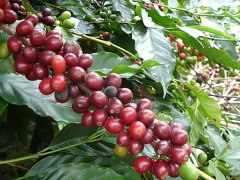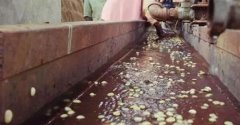How to make Costa Rican red honey coffee? Is Costa Rican red honey good to deal with coffee beans?

Professional coffee knowledge exchange more coffee bean information please follow the coffee workshop (Wechat official account cafe_style)
Suggestions on hand punching temperature, grinding degree and powder-to-water ratio of red honey in Tobushi, Costa Rica
Costa Rica has a long history of cultivating coffee, but in the past 10 years, the new method of "dry" treatment has become popular, collectively known as "honey treatment", which uses the scraper to adjust the scraping degree of the pulp. The output shows a "honey feeling" from light to strong with the color from light to dark (white, yellow-red-white, yellow-red-black), with acidity.
Complex aroma, thick feeling... Each has its own depth and advantages. Finca Salaca is now owned by the Maria Elena family. Almost all of the estates are planted with Villalobos species, only a few Kaddura species are planted. Villalobos is a branch of Tibica, which is characterized by delicate appearance, floral and citrus aromas and subtle acidity of apricots, peaches and plums. Between 1950 and 1960s, Costa Rica planted a large number of Villalobos species in the western valley, and up to now, a large part of the Villalobos species are still planted on land as high as the western valley. In the late 1960s, Dutch traders introduced Villalobos to Indonesia for planting.
Costa Rican coffee has always been regarded as the perfect type of classic flavor, with a balanced, clean, gentle and supple tone. This batch of coffee beans is a recent rookie in Costa Rica's microprocessing plant.
The raw bean treatment of the breeze factory (Monte Brisas) retains the unique flavor of Villalobos with red honey: elegant and rich fruit notes, blueberries, flowers, frankincense, chocolate, sweet and juicy acidity, delicate and smooth taste, aftertaste.
Luis Salazar, the second generation of the estate, believes that each micro-batch of coffee cherries at Salaca has different characteristics and should be treated more experimentally in order to find out the best flavor. In 2012, Luis Salazar established a breeze treatment plant (Monte Brisas Micromill). In the same year, Salaka Manor won the Costa Rican COE competition!
Vera Robles is a natural variety of Tibica found in Costa Rica. This variety is popular because of its obvious sweetness and high-quality acidity.
I didn't expect that a cup of coffee would have so many levels of performance in hot and cold. When the coffee is hot, cold and cold, there is such a big change--
You like to taste fresh and changeable, come and have a drink-it's really an amazing taste--
Flavor description: rich hot fruit notes, plums, brown sugar,
Frankincense, sweet and juicy sour, smooth taste and lingering finish.
Country: Costa Rica / Costa Rica
Production area: West Valley / West Valley
Producer: breeze treatment Plant / Monte Brisas Micromill Salaka Manor / Finca Salaca
Sea pull: 1750 meters
Variety: Vera Robles / Villalobos
Treatment: red honey treatment
Baking degree: medium and shallow baking
Important Notice :
前街咖啡 FrontStreet Coffee has moved to new addredd:
FrontStreet Coffee Address: 315,Donghua East Road,GuangZhou
Tel:020 38364473
- Prev

Karotu processing plant-the best Kenyan coffee processing plant Kenya Nyeri coffee flavor description
For the exchange of professional baristas, please follow the coffee workshop (Wechat official account cafe_style) Kenya Coffee Rikaroto processing Plant AB Kenya Nyeri Karogoto AB country: Kenya Kenya production area: Kali Nyeri processing Plant: Karotu processing Plant Karogoto altitude: 1800 meters varieties: SL28, SL34 Cooperative: Tekangu FCS producers: cooperation
- Next

What kind of coffee beans is best for ice drop coffee? introduction to the flavor characteristics of Niri coffee producing area in Kenya
Exchange of professional baristas please pay attention to the coffee workshop (Wechat official account cafe_style) dry aroma revealing plum and lemon peel aroma, with a very attractive sweet smell, hot drink is like traditional Kenyan coffee, full of black plum and smoky weight and thick sweet and sour, when the temperature decreases, it changes to citrus, honey, grapefruit, the overall acidity is bright and distinct. Ken
Related
- Detailed explanation of Jadeite planting Land in Panamanian Jadeite Manor introduction to the grading system of Jadeite competitive bidding, Red bid, Green bid and Rose Summer
- Story of Coffee planting in Brenka region of Costa Rica Stonehenge Manor anaerobic heavy honey treatment of flavor mouth
- What's on the barrel of Blue Mountain Coffee beans?
- Can American coffee also pull flowers? How to use hot American style to pull out a good-looking pattern?
- Can you make a cold extract with coffee beans? What is the right proportion for cold-extracted coffee formula?
- Indonesian PWN Gold Mandrine Coffee Origin Features Flavor How to Chong? Mandolin coffee is American.
- A brief introduction to the flavor characteristics of Brazilian yellow bourbon coffee beans
- What is the effect of different water quality on the flavor of cold-extracted coffee? What kind of water is best for brewing coffee?
- Why do you think of Rose Summer whenever you mention Panamanian coffee?
- Introduction to the characteristics of authentic blue mountain coffee bean producing areas? What is the CIB Coffee Authority in Jamaica?

